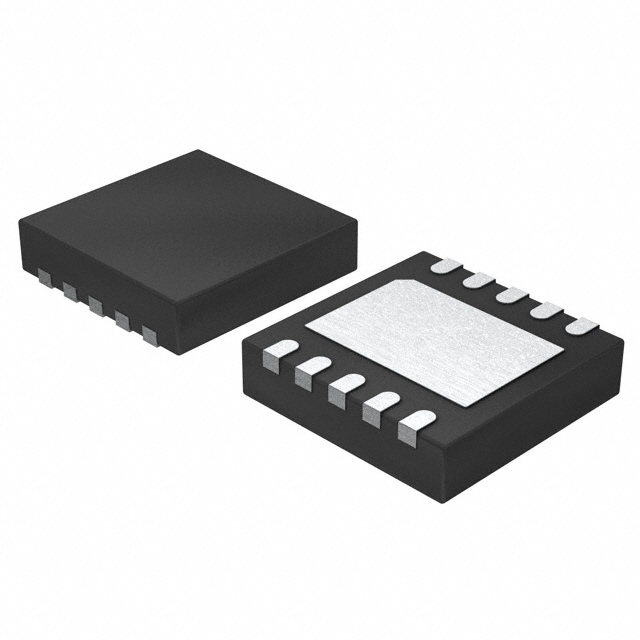LT3758AIDD#PBF
Product Overview
Category
The LT3758AIDD#PBF belongs to the category of integrated circuits (ICs) specifically designed for power management applications.
Use
This IC is commonly used in various power supply designs, including but not limited to DC-DC converters, LED drivers, and battery chargers.
Characteristics
- High efficiency: The LT3758AIDD#PBF offers high efficiency conversion due to its advanced architecture and design.
- Wide input voltage range: It can operate with input voltages ranging from 3V to 40V, making it suitable for a wide range of applications.
- Adjustable output voltage: The output voltage can be easily adjusted using external resistors or feedback components.
- Current mode control: The IC utilizes current mode control for improved stability and response.
Package and Quantity
The LT3758AIDD#PBF is available in a small and compact 8-lead DFN package. It is supplied in tape and reel packaging, with a quantity of 250 units per reel.
Specifications
- Input Voltage Range: 3V to 40V
- Output Voltage Range: Adjustable
- Maximum Output Current: 5A
- Switching Frequency: Up to 500kHz
- Operating Temperature Range: -40°C to 125°C
Pin Configuration
The LT3758AIDD#PBF features an 8-lead DFN package with the following pin configuration:
- VIN: Input voltage pin
- GND: Ground reference pin
- FB: Feedback pin for output voltage regulation
- VCC: Supply voltage pin
- SW: Switching node pin
- SS: Soft-start pin for controlled startup
- RT/CLK: External resistor or clock frequency setting pin
- SYNC: Synchronization pin for multiple ICs
Functional Features
- Wide input voltage range allows for versatile applications.
- Adjustable output voltage provides flexibility in power supply design.
- Current mode control ensures stability and improved transient response.
- Soft-start feature enables controlled startup, reducing stress on components.
- Synchronization capability allows for parallel operation of multiple ICs.
Advantages and Disadvantages
Advantages
- High efficiency conversion leads to energy savings.
- Wide input voltage range accommodates various power sources.
- Compact package size saves board space.
- Current mode control enhances stability and response.
- Synchronization capability enables scalability in power supply designs.
Disadvantages
- Limited maximum output current (5A) may not be suitable for high-power applications.
- Requires external components for proper operation, increasing overall system complexity.
Working Principles
The LT3758AIDD#PBF operates as a step-down DC-DC converter. It utilizes a switching regulator topology to efficiently convert the input voltage to a lower, regulated output voltage. The IC employs current mode control, where the inductor current is sensed and used for feedback control. This control scheme ensures stable and responsive operation, even under varying load conditions.
Detailed Application Field Plans
The LT3758AIDD#PBF finds application in various fields, including but not limited to:
- Industrial power supplies: The IC can be used in industrial equipment that requires efficient and reliable power conversion.
- Automotive electronics: It is suitable for automotive applications such as LED lighting systems, battery chargers, and power management modules.
- Renewable energy systems: The LT3758AIDD#PBF can be employed in solar power systems, wind turbines, and other renewable energy applications.
- Consumer electronics: It is well-suited for portable devices, battery-powered gadgets, and other consumer electronic products.
Detailed and Complete Alternative Models
- LT3758: Similar to LT3758AIDD#PBF, but with a different package option (e.g., SOIC).
- LT3759: Offers higher maximum output current (up to 10A) for more demanding applications.
- LT3760: Provides additional features such as adjustable frequency and phase modulation capability.
These alternative models offer similar functionality and can be considered based on specific application requirements.
Word count: 550 words
Senaraikan 10 soalan dan jawapan biasa yang berkaitan dengan aplikasi LT3758AIDD#PBF dalam penyelesaian teknikal
Sure! Here are 10 common questions and answers related to the application of LT3758AIDD#PBF in technical solutions:
Q: What is LT3758AIDD#PBF? A: LT3758AIDD#PBF is a high voltage, current mode DC/DC controller designed for step-down, step-up, and inverting applications.
Q: What is the input voltage range of LT3758AIDD#PBF? A: The input voltage range of LT3758AIDD#PBF is from 3V to 100V.
Q: What is the maximum output current that LT3758AIDD#PBF can handle? A: LT3758AIDD#PBF can handle a maximum output current of up to 20A.
Q: Can LT3758AIDD#PBF be used for both step-down and step-up applications? A: Yes, LT3758AIDD#PBF can be used for both step-down (buck) and step-up (boost) applications.
Q: Does LT3758AIDD#PBF require an external MOSFET? A: Yes, LT3758AIDD#PBF requires an external N-channel MOSFET for its operation.
Q: What is the switching frequency range of LT3758AIDD#PBF? A: The switching frequency range of LT3758AIDD#PBF is from 100kHz to 500kHz.
Q: Is LT3758AIDD#PBF suitable for automotive applications? A: Yes, LT3758AIDD#PBF is suitable for automotive applications as it has a wide input voltage range and operates over a wide temperature range.
Q: Can LT3758AIDD#PBF operate in a synchronous rectification mode? A: Yes, LT3758AIDD#PBF can operate in a synchronous rectification mode for improved efficiency.
Q: Does LT3758AIDD#PBF have built-in protection features? A: Yes, LT3758AIDD#PBF has built-in protection features such as overvoltage protection, overcurrent protection, and thermal shutdown.
Q: What is the package type of LT3758AIDD#PBF? A: LT3758AIDD#PBF is available in a 16-lead, 4mm x 3mm DFN package.
Please note that these answers are general and may vary depending on the specific application and requirements. It is always recommended to refer to the datasheet and consult the manufacturer for detailed information and application-specific questions.


